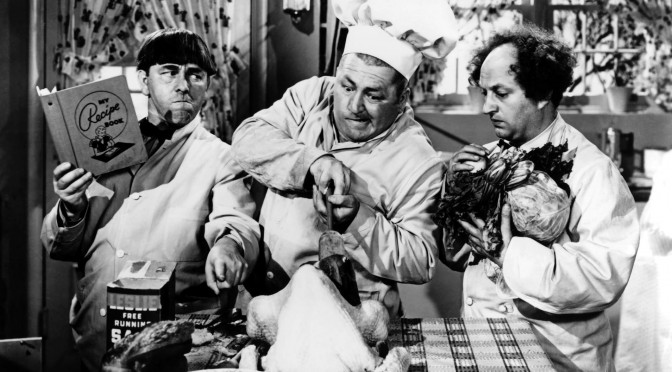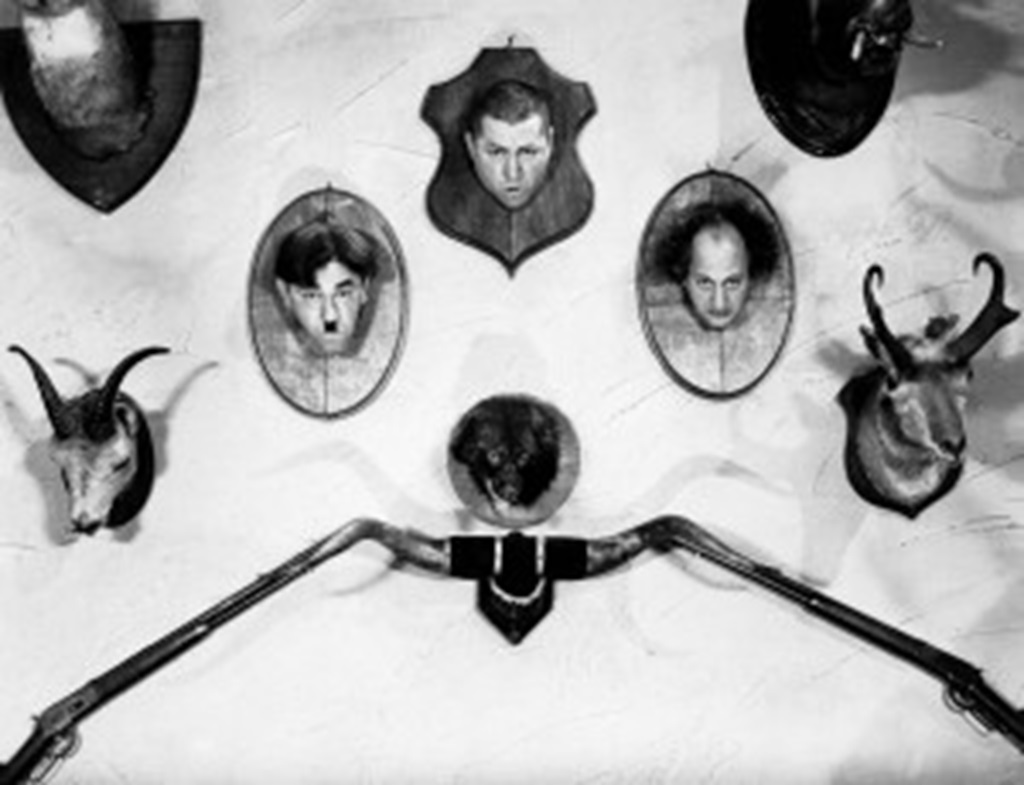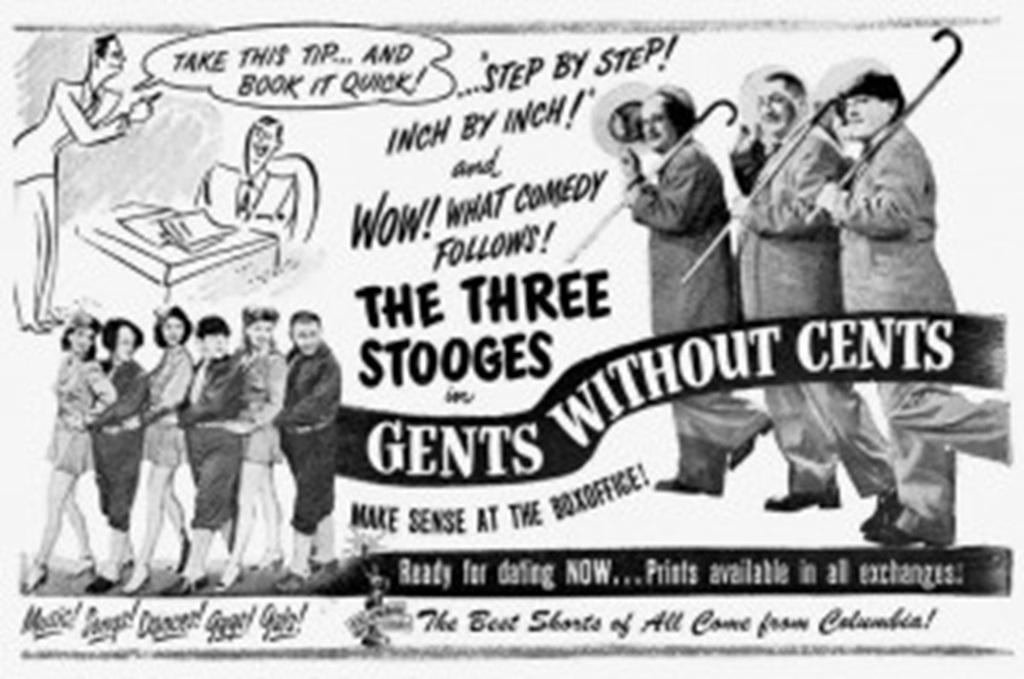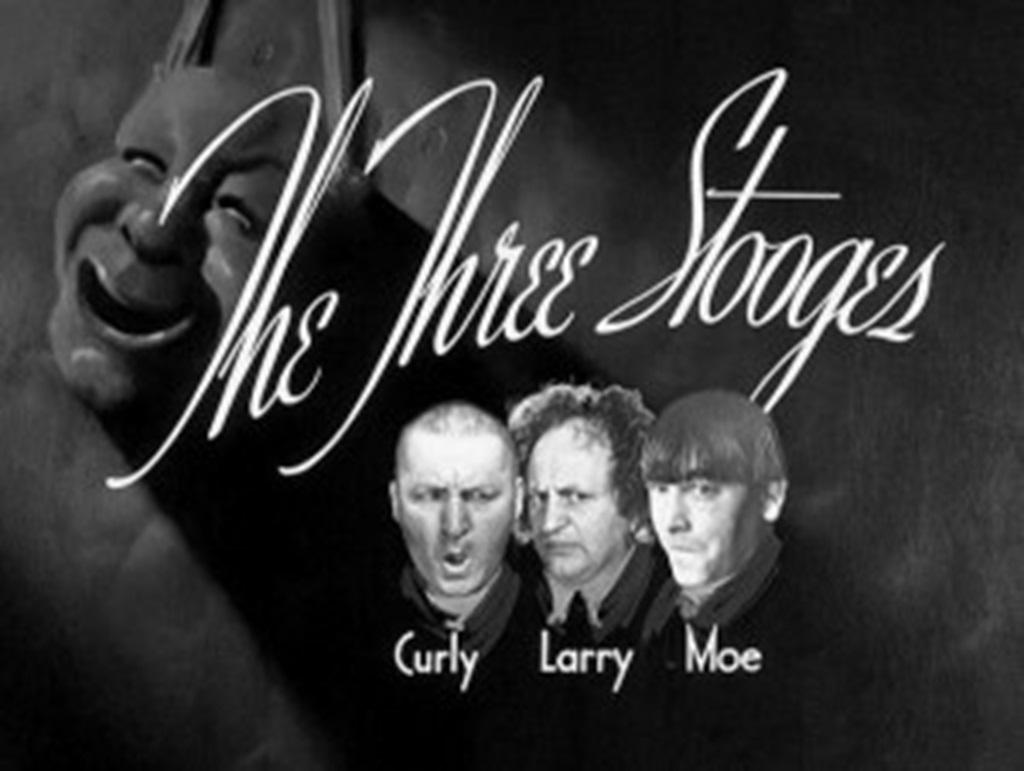Reviews Of 97 Three Stooges Shorts. Please go through it till the end!
A trio of comedians made a lasting impression on popular culture in 1934. Producer Jules White skillfully guided Moe Howard, Larry Fine, and the brilliant Curly Howard into the Columbia Short Subjects Department.
After making their Columbia debut a year earlier, the Three Stooges were under the skillful direction of slapstick master Del Lord, and they soon found their comic rhythm in the two-reel comedy genre.
Also Read: Blu-Ray Review: Martin Scorses’s World Cinema Project No. 3, From The Criterion Collection
Review of 97 Three Stooges Shorts: Summary Of All
It was September of 1969 when I met the Stooges, thanks to Kansas City’s KMBC. I first became aware of the wild world of the Three Stooges when I was five years old, thanks to the beautiful movie “We Want Our Mummy.”
The whole experience was a joyful whirlwind, from the opening scene to the ending credits. It was pretty magical to watch Moe, Larry, and Curly’s antics; it was an engaging experience that left me wanting more.
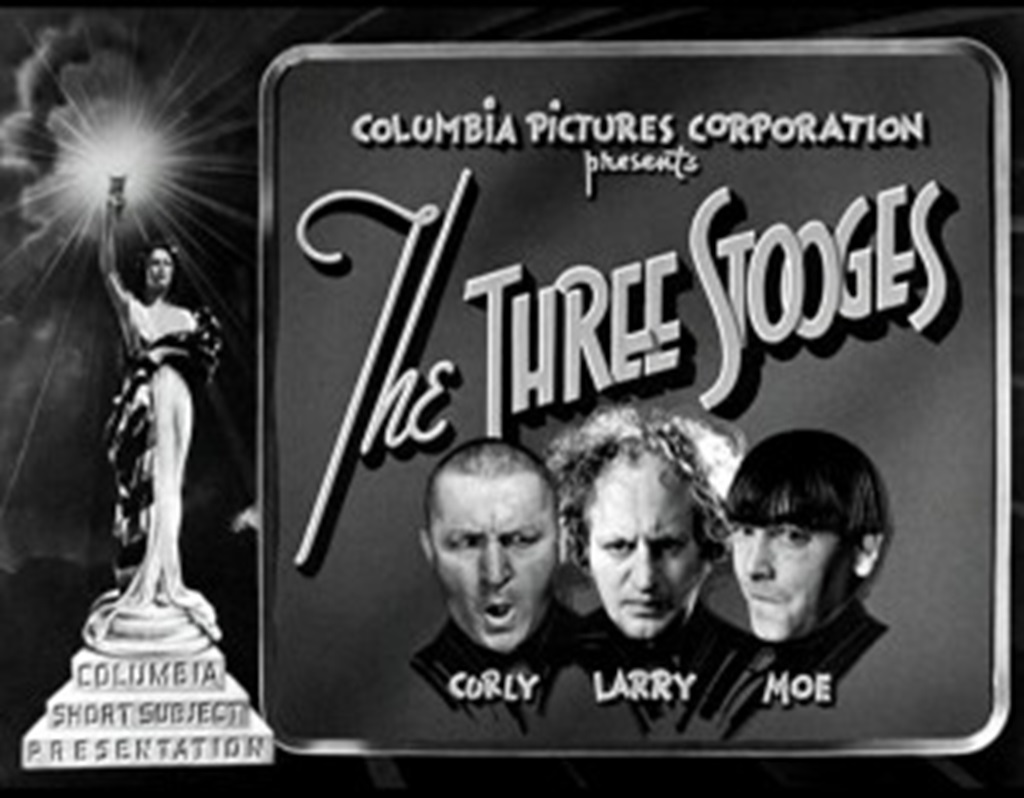
The live-action cartoon brilliance of Moe, Larry, and Curly was far superior to that of the popular Flintstones, which aired on weekday afternoons and followed the Stooges.
Their energetic performances brought the screen to life, a symphony of sight gags and sound effects with unmatched charm.
When I was five years old, the Stooges were my idols in real life, surpassing even the most impressive animated shows that could be found on TV.
It was no coincidence that the Three Stooges remained popular on television and in films. Their distinct style of physical humor flourished in brief, energetic bursts, and the two-reel format proved the perfect medium.
Every farcical masterwork that Del Lord helmed became an homage to their comic genius, winning over crowds and cementing their status as entertainment icons.
During my early years, everything was always “All Curly, All the Time.” The two-reelers with Curly Howard were always there, no matter where I moved or what TV station I watched.
Shemp, Joe, and Curly Joe made sporadic appearances in the mid-1970s, but the magic stopped with Curly’s stroke in 1946.
My taste in humor changed as I got older, favoring the Marx Brothers, Laurel & Hardy, Chaplin, and Keaton above the Stooges. The show continued, but it was simply not the same without Curly.
Since local TV had stopped airing Moe, Larry, and Curly, their antics became more available with the advent of home video in the early ’80s, which renewed my fascination with them.
The Stooge comeback on home video coincided with Jump ‘n the Saddle Band’s 1983 smash “The Curly Shuffle,” which peaked at #15 on the Billboard Hot 100.
All of the Curly masterpieces had been released on VHS by Columbia by 1996, which filled in the blanks in my boyhood.
Their whole discography from 1934 to 1959 is now easily accessible to us thanks to streaming services and DVDs.
Fifty years after my first Stooge encounter, I have revisited the golden Curly interval, providing summaries and a four-star rating system for each of the 97 shorts.
Though much has been written about the squad, I hope to offer novel ideas and bring back fond memories. Let the Golden Age of Stoogery begin right now!
Woman Haters (May 5, 1934)
Larry takes an unexpected lead at their Columbia premiere, and his dialogue rhymes endlessly.
This pre-code musical gem is enjoyable despite its unlucky beginning, mainly because of Marjorie White’s chemistry with the three and the timeless song “My Love, My Life, My All.” Expert cinematography is provided by the late great Joseph August.
The next two-reeler offers a giant leap ahead, though it’s not the worst.
Punch Drunks (July 13, 1934)
Punch Drunks may not have had “Pop Goes the Weasel” as their theme song, but they should have.
This first Stooge classic is a hilarious knockout that features Moe, Larry, and Curly’s ageless characterizations. This 17-minute gems, originally titled A Symphony of Punches, makes Woman Haters seem like a simple audition.
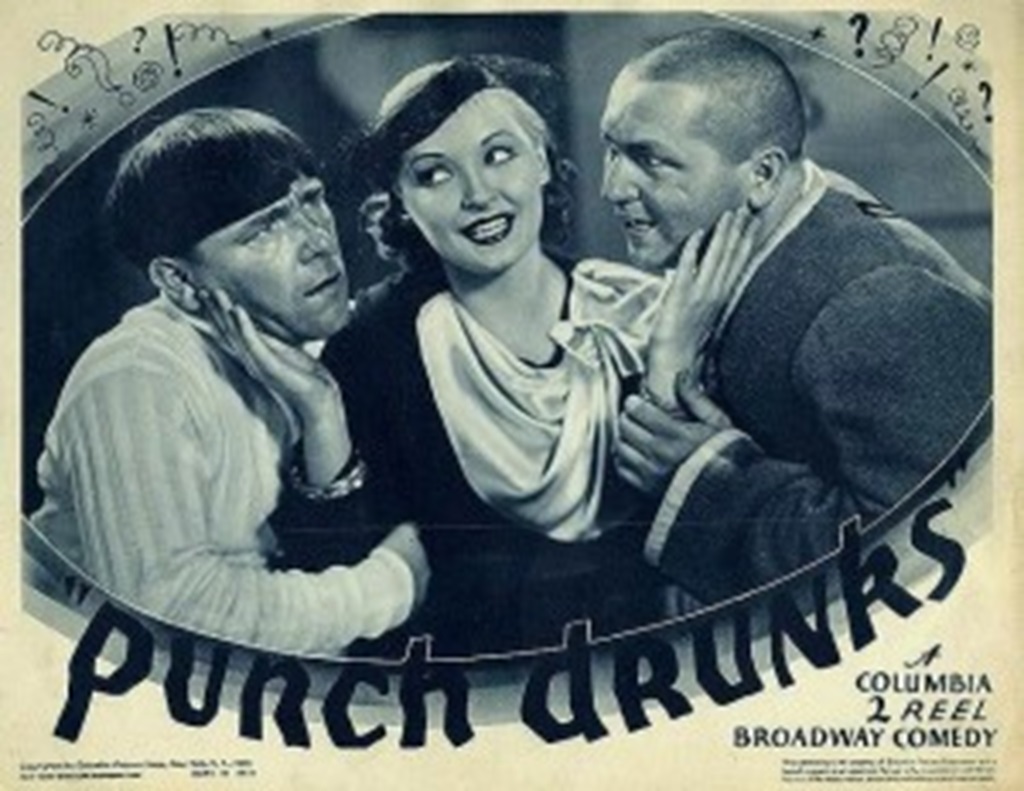
Seeing Arthur Housman in a rare, sober state is a pleasant surprise. Interestingly, Punch Drunks was the only Stooge short to be included in the Library of Congress’s National Film Registry when it did so in 2002.
Men in Black (September 28, 1934)
“Calling Dr. Howard, Dr. Fine, Dr. Howard!”
Faster than Punch Drunks but almost too intense, the Stooges’ first Oscar-nominated short (which lost to La Cucaracha) paves the way for hits like Calling All Curses and Dizzy Doctors.
Even with their abundance of laughter, Moe, Larry, and Curly appear a little reserved. Men in Black features some great moments but doesn’t show off the Stooges to their full entertaining potential.
Three Little Pigskins (December 8, 1934)
This comedy set during the depression’s-era conveys the spirit of classic Stooges humor in its early moments. However, the anticipated football climax isn’t as funny as it could be; No Census, No Feeling is funnier.
Though Phyllis Crane, Lucille Ball, and Gertie Green are all given billing, it’s puzzling that Columbia fails to give comic heavyweight Walter Long credit for his one and only Stooge performance.
Horses’ Collars (January 10, 1935)
In this fifth Columbia short, Curly steals the show and keeps the audience laughing nonstop. Horses’ Collars includes a few slow spots, but overall, it’s funnier than the three of them have done before.
It’s a lovely touch to have “B-western” heavyweight Fred Kohler as Double Deal Decker. Although Clyde Bruckman’s career as a director was cut short by drunkenness, he made a lasting impression with Horses’ Collars, directing his lone Stooge two-reeler with great style.
Restless Knights (February 20, 1935)
This medieval spoof gains grandeur from the settings borrowed from Boris Karloff’s The Black Room, but the tempo is a letdown, and the unsatisfactory resolution is unsatisfying.
Even with humorous moments such as the wrestling fight between Moe and Curly and the endearing Walter Brennan, one can’t help but hope for a more satisfactory conclusion for Restless Knights.
Notably, it’s the first time director Charles Lamont and actor Stanley Blystone have appeared in a Stooge film.
Pop Goes the Easel (March 29, 1935)
Del Lord is perfection! Lord stands out among Columbia filmmakers for creating the fastest two-reels ever and broadening the trio’s comic aesthetic.
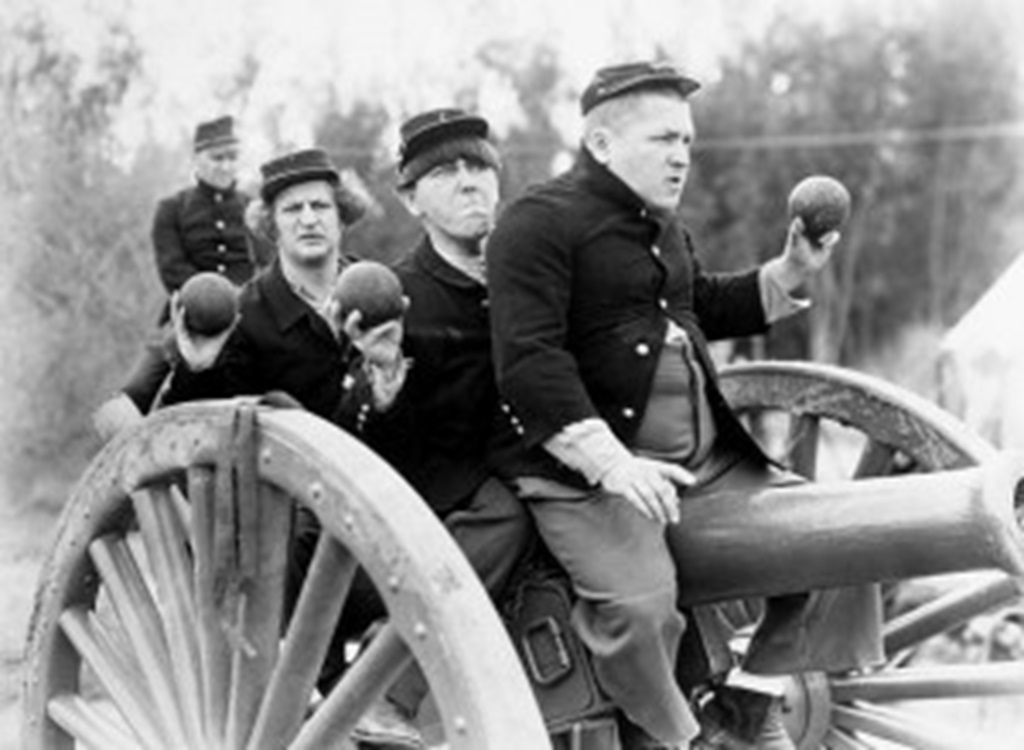
Pop Goes the Easel’s tempo gives the impression that Restless Knights was shot in slow motion. For the veteran of Mack Sennett, it was an unforgettable start, but Del and the Stooges were only getting started.
Possibly the first clay fight ever shown in a movie.
Uncivil Warriors (April 26, 1935)
Curly: “I was lost! All by myself!”
It’s one of my all-time favorite opening shots from a Stooge classic. Del Lord’s savvy direction is matched with Felix Adler’s hilarious screenplay.
Even though Curly is a genius, Moe and Larry have a great showing in the Civil War comedy. Bravo, particularly, to Bud Jamison for his role as Colonel Buttz.
The last movie where the Stooges appeared in studio promotional materials under the names “Howard, Fine, and Howard.”
Pardon My Scotch (August 1, 1935)
While Moe, Larry, and Curly have everything needed for whiskey distribution, high society is still a different story.
This exquisitely made two-reeler extends the winning streak for Del Lord. Among the many highlights is Curly’s portrayal of “The Dance of the Rolls” during supper, which is followed by Moe’s obscene use of breadsticks.
James C. Morton, a well-known supporting actor in the Stooges stock company, was given screen credit for this brief role.
Hoi Polloi (August 29, 1935)
Professor Richmond: “I reiterate that environment is the keynote of social distinction.”
Professor Nichols: “Nonsense! Heredity is the backbone of social life.”
If you enjoyed the comedy of Dan Aykroyd and Eddie Murphy in Trading Places (1983), you’ll be comfortable with Stooge’s journey into social satire.
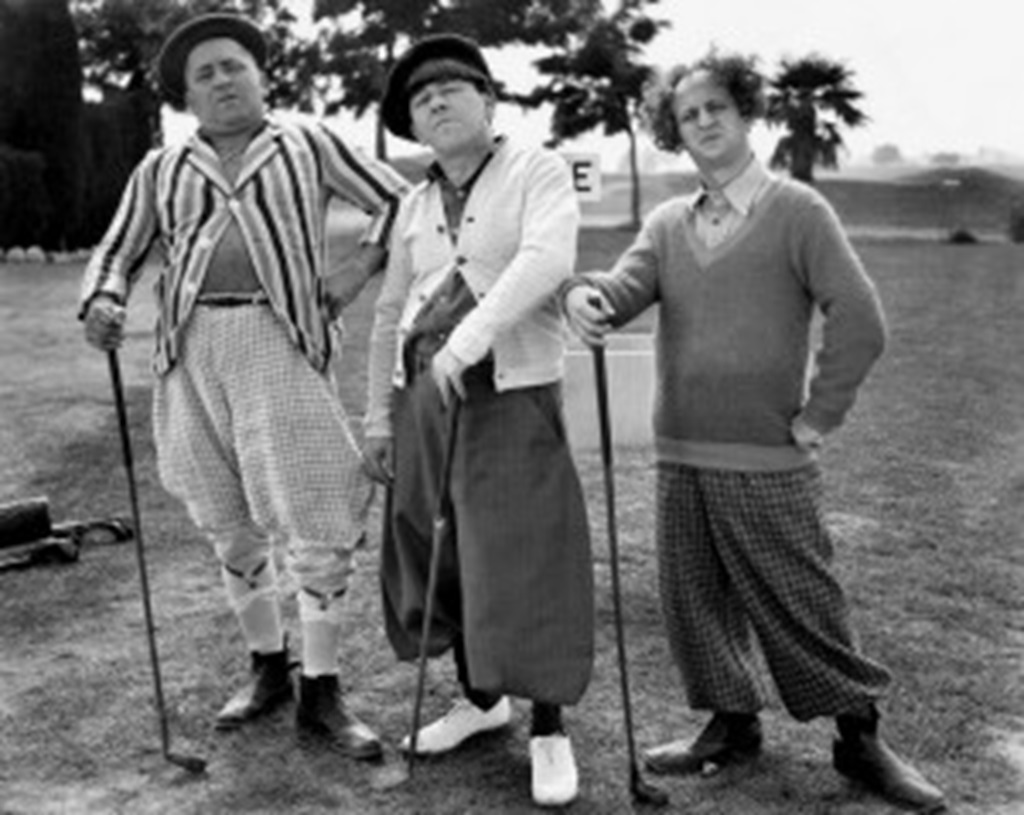
Among the two-reelers on the team, it is exceptional and surpasses the historically pensive Half-Wits Holiday.
Packed with comedic moments, such as a crazy dance class with Geneva Mitchell that was eventually reused in 1941’s In the Sweet Pie and Pie, it also has an uncommon underscore for a short film directed by Del Lord.
Three Little Beers (November 18, 1935)
Easy Street, Cops, and The Music Box are legendary comedic shorts that Three Little Beers can easily compete with.
Moe, Larry, and Curly provide a riotous climax evoking memories of Buster Keaton’s What! No Beer? (1933), capping off an incredible comedic coup. Not anything less than a miniature masterpiece is the result.
Del Lord and the Stooges have effortlessly nailed their slapstick niche with four consecutive outstanding two-reelers.
Ants in the Pantry (February 6, 1936)
An encouraging start to Jack White’s (formerly known as Preston Black) inspirational but regrettably brief directorial career at Columbia.
Jack White is Jules White’s older brother. After debuting as “pest men,” The Stooges return to high society and navigate through pandemonium.
Unfortunately, the “fox hunt” that is tacked on adds little value, and the movie might have ended at 16:27. Thankfully, Termites of 1938 exhibits a substantial advancement, culminating in a more gratifying resolution.
Movie Maniacs (February 20, 1936)
More: “There’s a couple of thousand people in pictures who know nothing about it. Three more won’t make any difference. “
As the three storm into “Carnation Pictures,” Del Lord gains command and causes mayhem in Movie Maniacs. Even if the movie has everything, a satisfying ending is elusive—a problem that often arises in the Curly era.
This playful look at old Hollywood is evocatively captured on the Columbia backlot. In one of his best parts ever, character actor Harry Semels plays the irritated director Cecil Z. Swinehardt.
Half Shot Shooters (April 30, 1936)
As the three storm into “Carnation Pictures,” Del Lord gains command and causes mayhem in Movie Maniacs.
Even if the movie has everything, a satisfying ending is elusive—a problem that often arises in the Curly era.
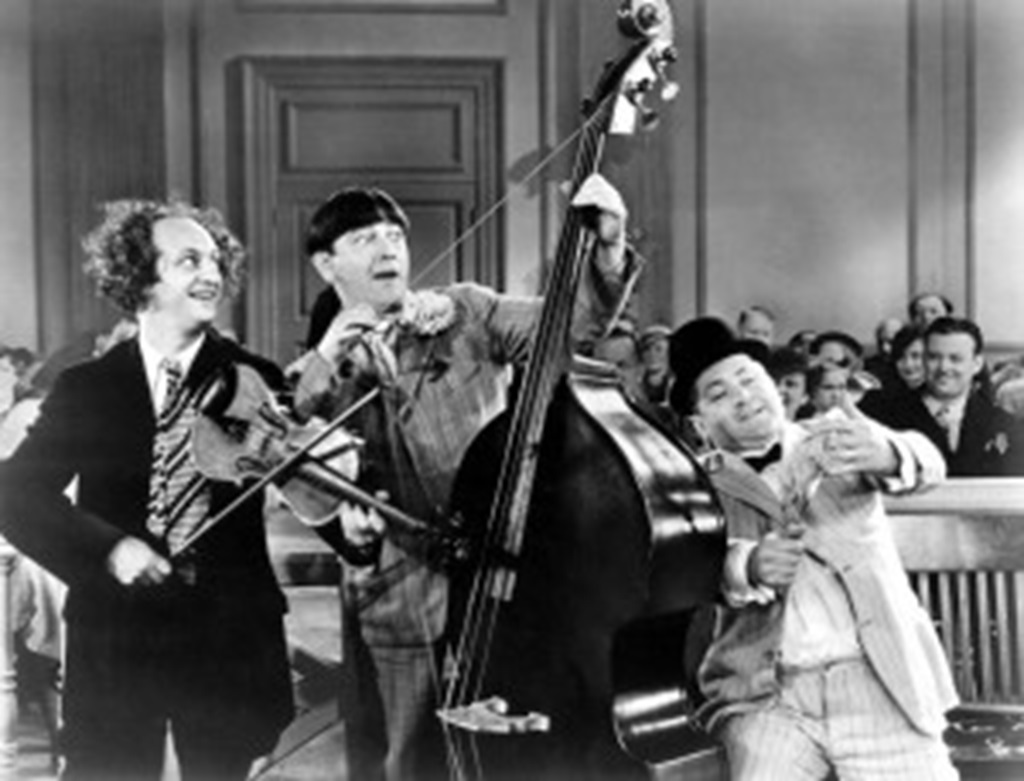
This playful look at old Hollywood is evocatively captured on the Columbia backlot. In one of his best parts ever, character actor Harry Semels plays the irritated director Cecil Z. Swinehardt.
Disorder in the Court (May 30, 1936)
Moe’s response to Larry’s jungle yell (followed by the proverbial slap): “You’re in a court, not in the woods, Tarzan.”
The ultimate Stooge classic, Disorder in the Court, has outstanding performances by Moe, Larry, and Curly and a noteworthy supporting cast.
The best work to date from directors Preston Black and Jack White, it’s the only Curly short to be shown in real time without dissolves or wipes.
The Volume One: 1934-1936 DVD has excellent print quality, especially considering the decades-long history of poor public domain editions. A personal fave.
A Pain in the Pullman (June 27, 1936)
Titled as “Stooges on a Train,” this outstanding film starred Preston Black and Jack White is evidence of his incredibly chaotic directing style.
A Pain in the Pullman is a mainly hilarious comedy with a unique touch of a pet monkey thrown in. James C. Morton and Bud Jamison’s presence emphasizes their importance to the Stooges stock firm.
False Alarms (August 16, 1936)
False Alarms, Del Lord’s best short of 1936, doesn’t have an iconic set piece, but the chuckles it offers more than makeup for it.
The firefighting Stooges try to fix Captain Stanley Blystone’s car in John Grey’s original screenplay, which ups the comic ante. Particularly when contrasted with his portrayal of a vicious sergeant in Half Shot Shooters, Blystone’s part is noticeably better.
There is no denying Del Lord’s influence in the crazy vehicle chase through Los Angeles. False Alarms also demonstrates why, in situations without Curly, Moe and Larry form a fantastic comedic duo.
In retrospect, “The Two Stooges” would have made sense following Shemp’s passing in 1955. (No issue, no Besser.)
Whoops, I’m an Indian! (September 11, 1936)
There’s humor in store whenever the Stooges step outside. The film’s highlight is the sequence where Curly goes fishing, and Bud Jamison, who plays Pierre so well, gives one of his best performances ever.
Whoops, I’m an Indian! is a disappointment due to its abrupt finale, but it had the potential to be a Stooge classic. Unfortunately, a lost or decomposed negative means that the print quality is not as sharp as other Columbia two-reelers.
Still, there’s always the chance that a perfect 35mm print will be found.
Slippery Silks (December 27, 1936)
In Slippery Silks, Preston Black/Jack White returns to provide a taste of high-society humor.
After a few viewings, the uneven short starts to grow on you. The cream-puff fight takes center stage, outshining even In the Pie and Sweet Pie.
Interestingly, Symona Boniface and Vernon Dent relish their first major parts in the Stooges stock company.
Grips, Grunts and Groans (January 15, 1937)
Curly: “If I’m gonna get beat up, I wanna get paid for it!”
Punch Drunks, Grips, Grunts, and Groans has been updated so that it is full of hilarious energy and beautiful interactions between Curly and Larry.
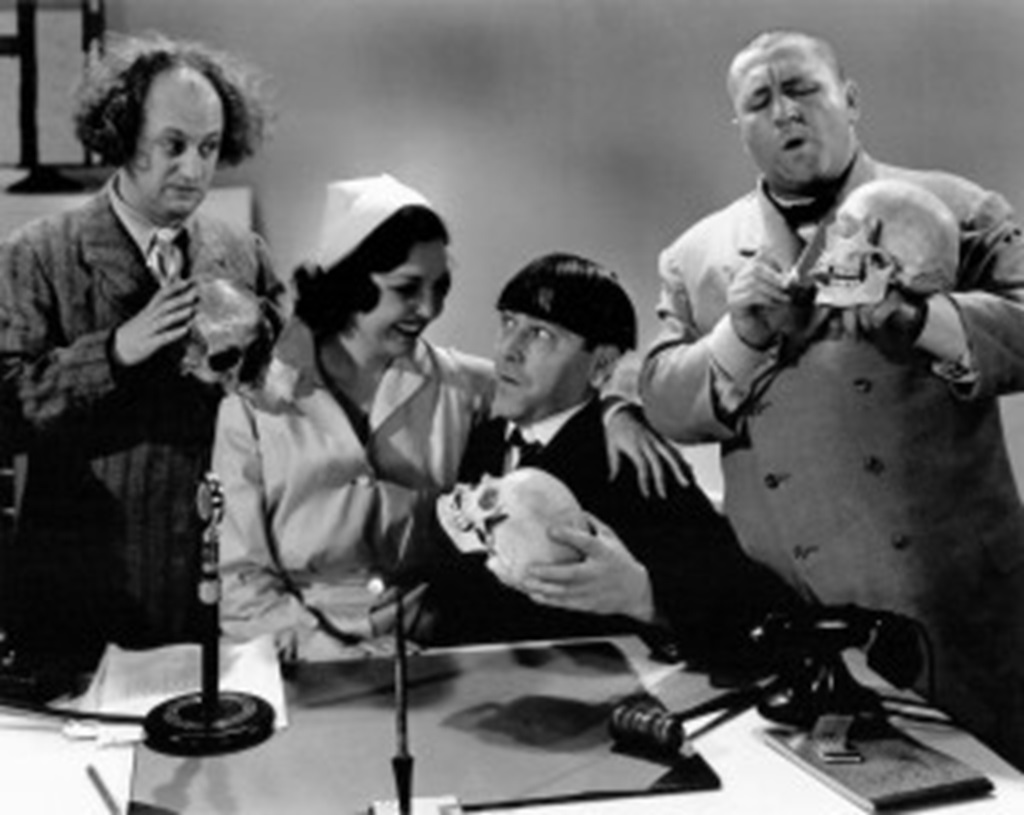
One of the best Stooge endings is the hilarious wrestling conclusion. Even though it might not be as iconic as Punch Drunks, this short is hilarious and moves quicker.
Dizzy Doctors (March 19, 1937)
Moe, Larry, and Curly demonstrate their sales skills in a Stooge classic that ranks among the top ten.
Dizzy Doctors, one of the fastest two-reelers in movie history, demonstrates Del Lord’s directing talent as it moves at breakneck speed.
No frames are lost in Charles Nelson’s flawless editing, which won an Academy Award for Picnic in 1956. I haven’t yet seen a quicker-paced comedy short on my screen.
3 Dumb Clucks (April 17, 1937)
A worthy 1937 effort from Del Lord, albeit his poorest one—second-rate Stooges are better than none at all. Not a dull moment occurs, and Curly is excellent in his one and only dual part.
For the climax, which required a grandiose sight joke (the flagpole climb fails miserably), it’s unfortunate Del didn’t have a larger budget.
It’s one of those infrequent shorts where Curly’s hairpiece stunt duplicate is completely haired.
Back to the Woods (May 14, 1937)
“Back to the Woods,” Preston Black and Jack White’s last film as directors of the Stooges, may be a little long, but the humor never stops.
An unexpected delight is added by the deft reuse of “Whoops, I’m an Indian!”‘ s finale. A two-reeler is a hidden gem that gets better with time. Ideal for watching on Thanksgiving.
Goofs and Saddles (July 2, 1937)
There is just one dance when it comes to card decks: the “Curly shuffle.” Favorite Stooge Western Del Lord’s Victory has good production values, fun supporting work from Stanley Blystone, and surprisingly few slaps.
A 1937 masterpiece with hilarity on par with “Dizzy Doctors.”
Cash and Carry (September 3, 1937)
“Gee, Mr. President, you’re a swell guy!”
“Cash and Carry” is a true rarity because of its unusual fusion of New Deal optimism, unexpected sentimentality, and slapstick humor.
A captivating cinematic experience is produced by Lucien Ballard’s lensing in combination with Del Lord’s directing. Although I like its quirky nature, I’m glad the Stooges didn’t go for more two-reels along these lines.
In his invaluable 2017 work, “Hokum!: The Early Sound Slapstick Short and Depression-Era Mass Culture,” Rob King explores the nuances of “Cash and Carry.”
Playing the Ponies (October 15, 1937)
A welcome change of pace for the Stooges, with a memorable concluding shot, a gratifying happy ending, and a Larry spotlight.
Unlike the Marx Brothers’ overly drawn-out “A Day at the Races,” there are no lingeringly uncomfortable musical numbers here.
The second and last film directed by Charles Lamont about Stooge is a significant step up from the drab “Restless Knights.”
The Sitter Downers (November 26, 1937)
Every once in a while, a promising Stooge comedy is ruined by brevity. This adaptation of Buster Keaton’s housebuilding story, “One Week,” ends abruptly at the fifteen-minute point and lacks the spectacular ending of Buster’s 1920 masterpiece.
Still, there’s much to enjoy because of an excellent supporting cast.
Termites of 1938 (January 7, 1938)
The directing of “Termites of 1938” by Del Lord is influenced by co-producer Charley Chase, a comic genius who was moving to Columbia from Hal Roach Studios after fifteen years.
The film’s attractiveness is enhanced by its undertones, especially in the soundtrack. The results of Moe, Larry, and Curly’s unintentional escort roles are utterly fantastic.
Bess Flowers makes an unforgettable Stooge debut, and the gopher bomb-themed ending is a well-earned finale.
Wee Wee Monsieur (February 18, 1938)
I remember watching “Wee Wee Monsieur” as one of my first Stooge cartoons because of its catchy title. Just the timeless picture of Moe, Larry, and Curly as the Three Santas is reason enough to gain entry.
It stands out from other Stooge comedies because of the unique touch of setting the group in the French Foreign Legion. Vintage fun in the Del Lord mold.
Tassels in the Air (April 1, 1938)
This is the first of five short films directed by Charley Chase, and it features a lovely chemistry between Chase and the Three Stooges.
Curly’s passion is centered on tassels rather than cheese or perfume. The trio’s mishap enhances the humorous charm of their role as interior decorators for the nouveau riche (Bess Flowers and Bud Jamison).
Despite being a Stooge favorite, the experience is somewhat ruined by the film’s ambiguous conclusion, which is indicated by a hurried jump cut in the last frame. Notably, it’s the first time veteran producer Hugh McCollum has been credited with a Stooge.
Healthy, Wealthy, and Dumb (May 20, 1938)
The laughter never stops, and Del Lord’s direction keeps this set-bound Stooge adventure from feeling constrained.
“Healthy, Wealthy and Dumb” has the luxury of a generous 16 minutes, but the startlingly quick finish is the lone letdown.
I don’t think “A Missed Fortune” (1952) is all that great, but the Shemp version at least has a more satisfactory ending.
Violent is the Word for Curly (July 2, 1938)
Imagine the Stooges negotiating the world of academia; it’s an odd and entertaining scenario.
This concludes the most significant period of the Charley Chase era, which is most remembered for Moe, Larry, and Curly’s iconic performance of “Swingin’ the Alphabet.”
The gas station set utilized here is the same as in Chapter Four of Columbia’s 1938 serial “The Spider’s Web,” with the exception that it was called “Dennis Service Station” rather than “Acme.” There are many jokes and excellent service throughout.
Three Missing Links (July 29, 1938)
Jules White directs a spirited debut as the Stooge, acknowledging Monte Collins for one of his best-supporting turns.
Even while “Three Missing Links” may not rank as the most excellent Stooge entry, the turmoil in the forest becomes endearing after a few viewings. Curly is still a comic powerhouse, even when dressed as a gorilla.
Mutts to You (October 14, 1938)
An all-time favorite for kids, also referred to as “Three Stooges and a Baby,” is notable for its creativity, especially the dog-washing machine.
This short has a pleasantly unconventional touch, thanks to director Charley Chase. Notably, it has a rare happy ending and is one of the less violent Curly two-reels.
See whether “Queen of the Hollywood Extras,” Bess Flowers, gets a screen credit, a rare occasion in the Stooge comic canon.
Flat Foot Stooges (December 5, 1938)
After three entertaining shorts, Charley Chase stumbles in “Flat Foot Stooges.” It is everywhere, and not in a positive sense.
Although a few memorable scenes add a strange element, such as the duck that eats explosives, Chase’s one and only Stooge screenplay seems out of place.
The conclusion is puzzling and a significant downgrade from the firefighting shenanigans of “False Alarms.”
Three Little Sew and Sews (January 6, 1939)
Curly: “Gasoline don’t taste so good since Prohibition. They ain’t so careful like when they use it for makin’ gin.”
As the guys enlist in the Navy as tailors and inadvertently become involved with spies and a top-secret submarine, Del Lord wins with yet another Stooge masterpiece.
Curly rivals Chaplin in his pantomime skills, and the “black” finale has the hilarity of a Warner Bros. cartoon. “Three Little Sew and Sews” marks the beginning of the Stooges’ incredible three-year creative zenith.
We Want Our Mummy (February 24, 1939)
The Stooges’ first horror parody, a true classic, centers on Moe, Larry, and Curly’s search for King Rutentuten in Cairo.
Everyone is operating at total capacity thanks to Searle Kramer and Elwood Ellman’s gripping script. Interesting fact: The voice on the cab radio is Moe’s.
This is also the last performance of James C. Morton as the Stooge before he died in 1942.
A Ducking They Did Go (April 7, 1939)
While Del Lord’s follow-up to “We Want Our Mummy” falls short of expectations, “A Ducking They Did Go” is nevertheless lively entertainment.
The colorful cinematography by Lucien Ballard in the pond scenes and The Stooges’ stock company enhance the fun.
The contagious happiness on Curly’s face, as he harmonizes with Bud Jamison, is one particularly memorable moment. Sadly, the “A Pain in the Pullman” repurposed video makes for a lazy conclusion.
Yes, We Have No Bonanza (May 19, 1939)
One of the best Stooge westerns since “Goofs and Saddles,” it’s unfortunate that director Edward Bernds and protagonist Shemp could not capitalize on the early Del Lord production quality.
The scene’s highlight is Curly throwing a humorous rock at Moe during the prospecting scene.
Even though it’s unfortunate, the evident stunt double for Curly during the thrilling chase doesn’t detract from the whole experience.
A wonderful touch is the musical interlude in which The Stooges sing servers.
Saved by the Belle (June 30, 1939)
While not a classic, it is a far cry from Charley Chase’s lackluster “Flat Foot Stooges.” The director’s last two-reeler, Stooge, keeps things lighthearted even if it doesn’t have any really memorable visual gags.
LeRoy Mason and Carmen LaRoux provide solid backing in their respective Stooge roles. All in all, I thought Chase’s unconventional take on Stooge lunacy in his shorts was great.
The team lost a crucial filmmaker in 1940 due to the comedian’s sudden demise.
Calling All Curs (August 25, 1939)
Producer Jules White becomes one of the team’s regular directors at this crucial juncture in Stooge history, eventually supervising more two-reelers than Del Lord and continuing to the end with the 1959 stock-footage compilation “Sappy Bull Fighters.”
A childhood classic, “Calling All Curs,” features Curly at his most gregarious, even taking a rare minute to scold Moe in return.
This pet hospital adventure, complete with dognappers, has all the makings of a Stooge two-reeler, enhanced by Jules White’s directing style.
White’s most remarkable run of hits dates back to the 1939–1940 shorts “Calling All Curs” to “Rockin’ Thru the Rockies.”
Oily to Bed, Oily to Rise (October 6, 1939)
This Stooge classic was a mainstay of our after-school schedule in the early 1970s.
Curly’s wish comes true as the lads help Widow Jenkins fight against scammers on her farm. One particularly memorable scene saw Moe and Larry using Curly as a “human cork” to stop an oil gusher.
Possibly director Jules White’s best short.
Three Sappy People (December 1, 1939)
“The men you want are Doctors Ziller, Zeller and Zoller.”
Once again, Jules White delivers a popular song with “Three Sappy People.”
A perfectly calibrated comedy-slapstick comedy with a first-rate supporting ensemble that includes Don Beddoe, Lorna Gray, and the utterly endearing Ann Doran in her only appearance as the Stooges.
In a rare two-reeler, Jules choreographs an epic pastry fight in which Moe, Larry, and Curly unexpectedly bow out of the last frame.
You Nazty Spy! (January 19, 1940)
“You Nazty Spy!” is a political satire classic released nine months before Chaplin’s “The Great Dictator.” Even though it’s not the Stooges’ best song, the second half of the song had less laughter than the first after Moe’s famous balcony remark.
It feels a little long by Stooge standards at eighteen minutes. But the only sequel from the Curly era, “I’ll Never Heil Again,” excels because of more robust humor, faster pacing, and Moe’s constant Hitler mustache.
Rockin’ Thru the Rockies (March 8, 1940)
“Where are those three sun-baked hams?”
“Rockin’ Thru the Rockies” is a continually humorous two-reeler that surpasses other well-known Stooge classics.
The humor is enhanced by Curly’s intelligence and Kathryn Sheldon’s outstanding performance as Nell.
Unfortunately, this is Sheldon’s only appearance as a Stooge. With so many 1940s shorts available, it could be easy to overlook, but the film keeps a relentless pace and has several iconic moments, including the ice-fishing scene.
A Plumbing We Will Go (April 19, 1940)
My all-time favorite Stooge director is still Del Lord, and “A Plumbing We Will Go” is a hilarious comedy masterwork with Moe, Larry, and Curly at their most outrageous in the Columbia two-reel factory.
As the hapless cook, the incomparable Dudley Dickerson adds his unique touch. “Vagabond Loafers,” the 1949 remake, demonstrates that nothing can top perfection.
Nutty but Nice (June 14, 1940)
The first faux pas in the Stooge direction is Jules White’s emotion, which falls flat, and the “kidnapped father” narrative, which doesn’t work.
The Clyde Bruckman-Felix Adler script is the poorest 1940 short, lacking the customary flair even if Moe, Larry, and Curly shine.
How High is Up? (July 26, 1940)
“Well, it looks like good solid construction.”
In this hilarious Del Lord skit, The Stooges ascend to new comic heights on the 97th level, surpassing Harold Lloyd in skyscraper mayhem with a touch of deft rear projection.
Even with the somewhat drawn-out sweater routine, this is an engaging performance worthy of three ratings.
From Nurse to Worse (August 23, 1940)
With a beautiful blend of dogs and hospital chases, The Stooges explore the world of insurance fraud, with Jules White making a triumphant return.
A lovely touch is Moe’s voice over the police scanner. Unlike the subsequent Curly shorts, Jules skillfully incorporates short bursts of stock video, guaranteeing nonstop entertainment.
No Census, No Feeling (October 4, 1940)
Curly: “Are you married or are you happy?”
The brothers pretend to be census takers for the US government, which results in hilarious side trips and classic Stooges humor.
The football finale is more entertaining than “Three Little Pigskins,” and it’s fun to see Symona Boniface back in the role of the alum-spiked bridge party hostess.
One of the numerous Stooge two-reelers I found in the mid-1980s, Del Lord’s Gem provides the goods.
Cookoo Cavaliers (November 15, 1940)
Jules White’s little-known masterpiece has Curly’s excellent pantomime, enhanced by the lovely Dorothy Appleby, one of the Stooges’ best performers.
A strange continuity error involving a missing dog distracts from the humor, a rare comic achievement focused on a beauty parlor.
Boobs in Arms (December 27, 1940)
Once more, Jules White uses his sorcery to lead the Stooges into a furious conflict full of deadly humor.
A deft adaptation of Laurel & Hardy’s 1935 The Fixer Uppers highlights the distinct comic style of the Stooges.
Richard Fiske, the brash drill sergeant, finds his Stooge groove at the young age of 24.
So Long Mr. Chumps (February 7, 1941)
As our heroes pursue “honest man” Convict #41144, played by Stooge regular Eddie Laughton, Jules White arranges a prison adventure.
The dazzling screenplay by Felix Adler and Clyde Bruckman highlights the director’s skill.
One of the most memorable endings for the Stooges is Curly’s spontaneous rock pile scene, which culminates in a beautiful interplay between Curly and Moe.
Dutiful but Dumb (March 21, 1941)
“I’m positive about the negative, but a little negative about the positive.”

